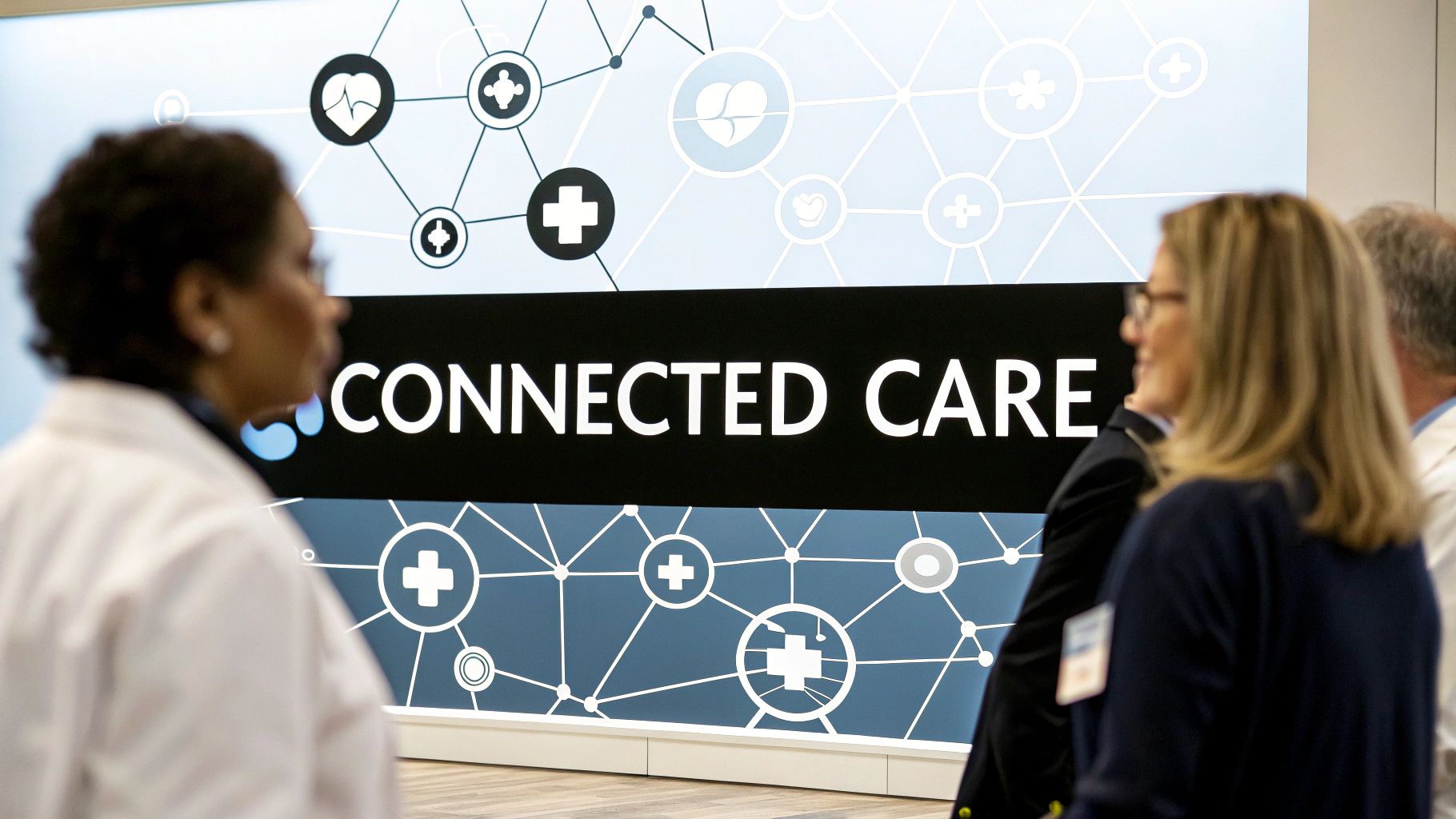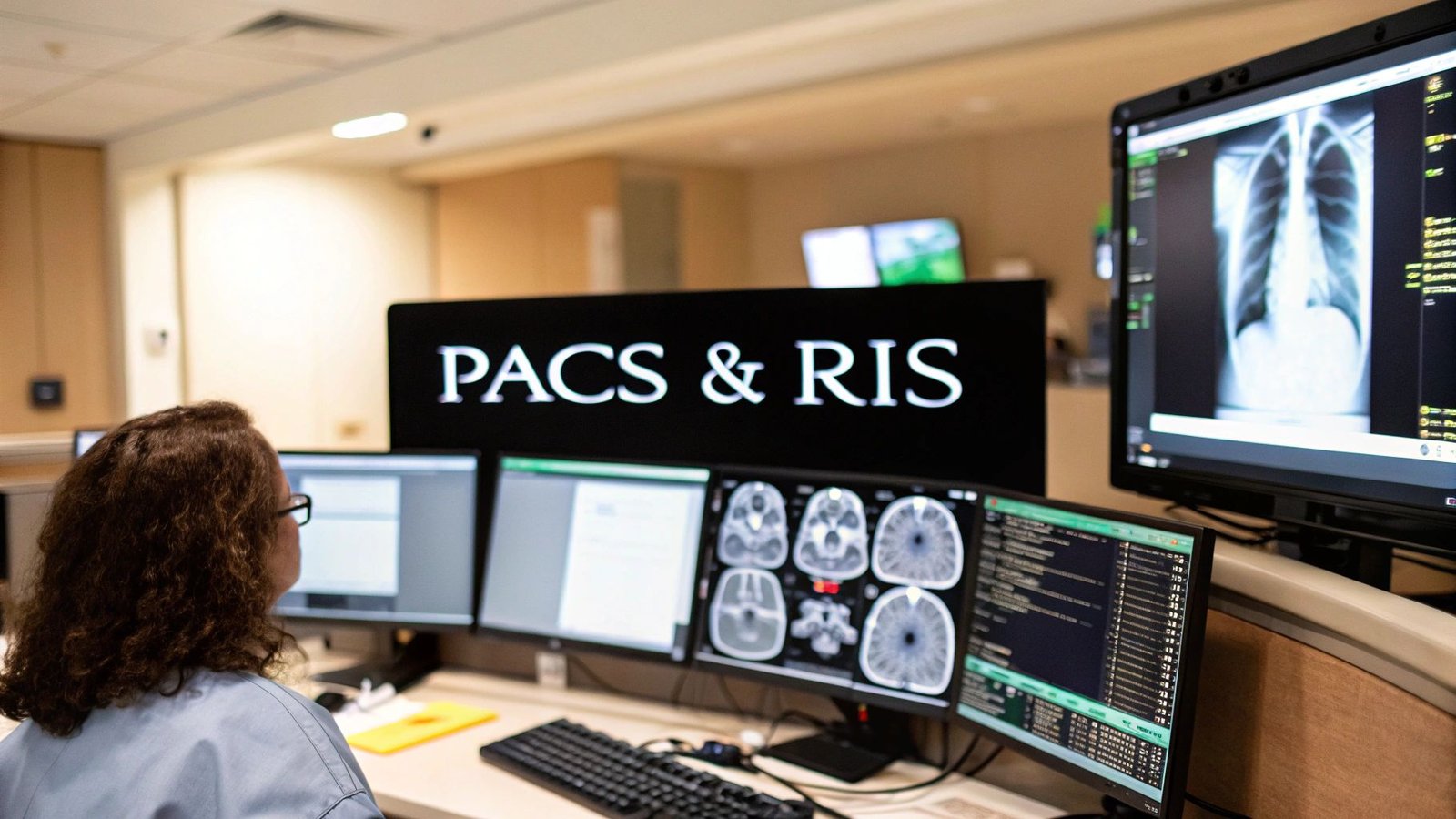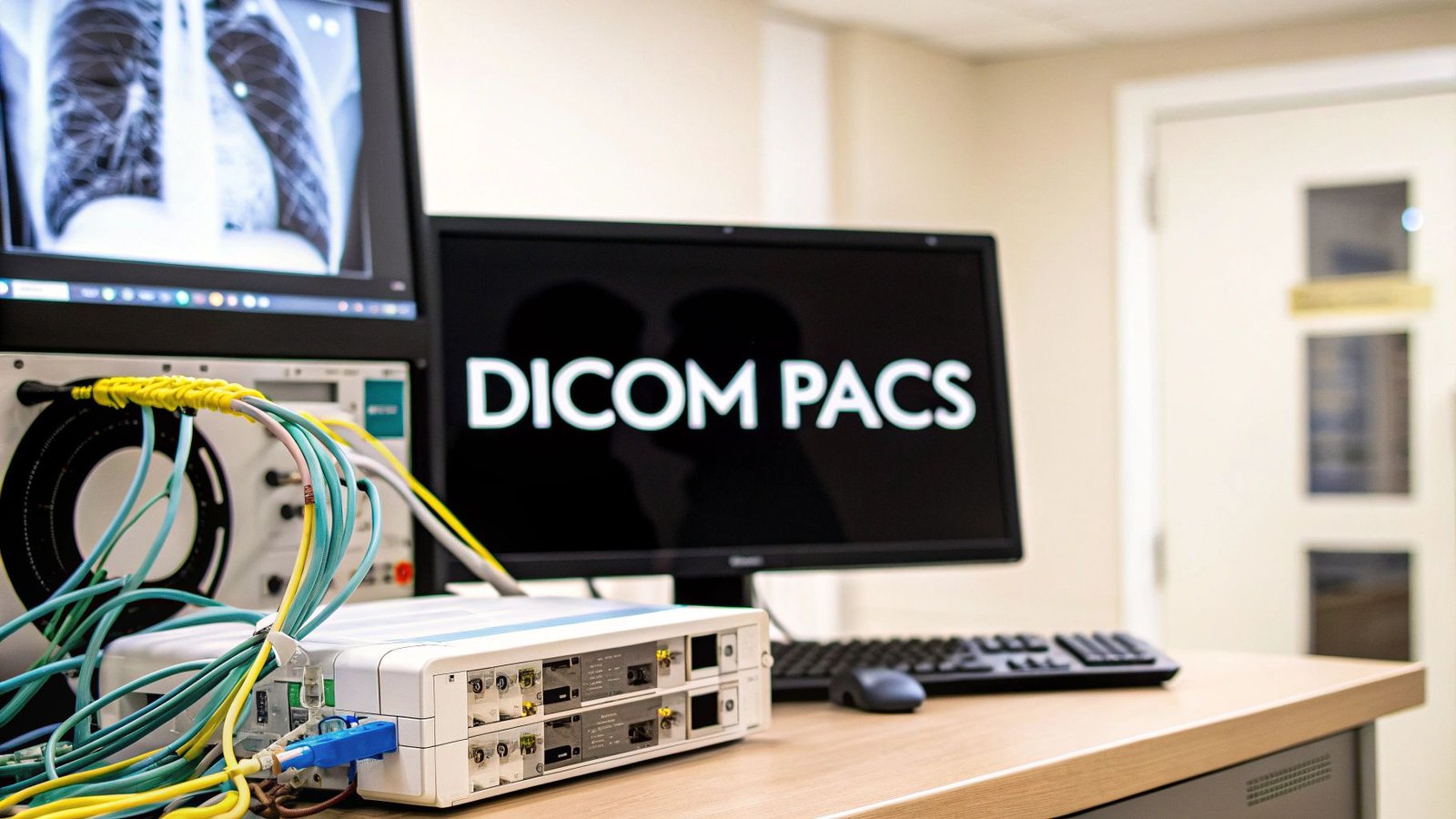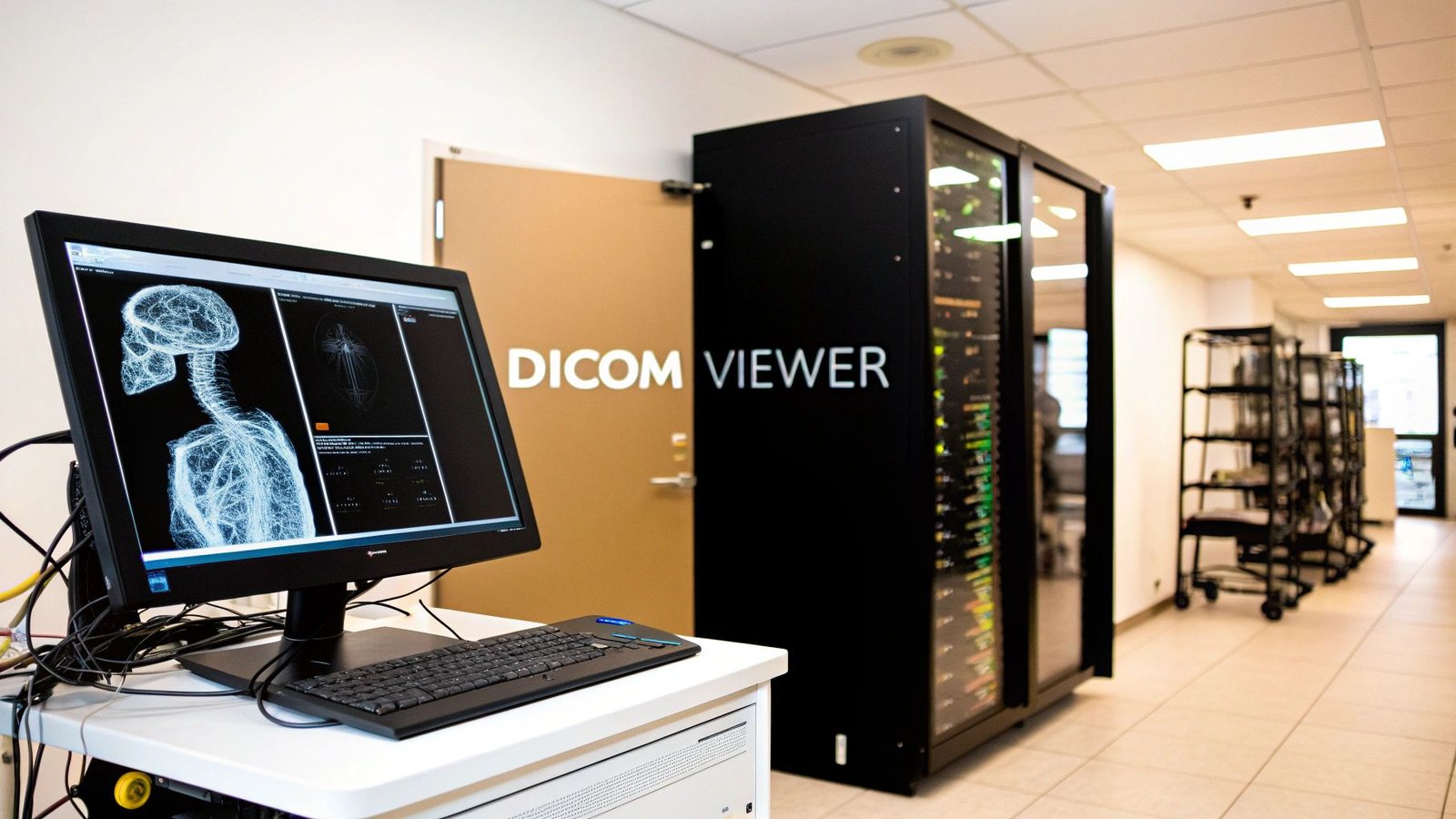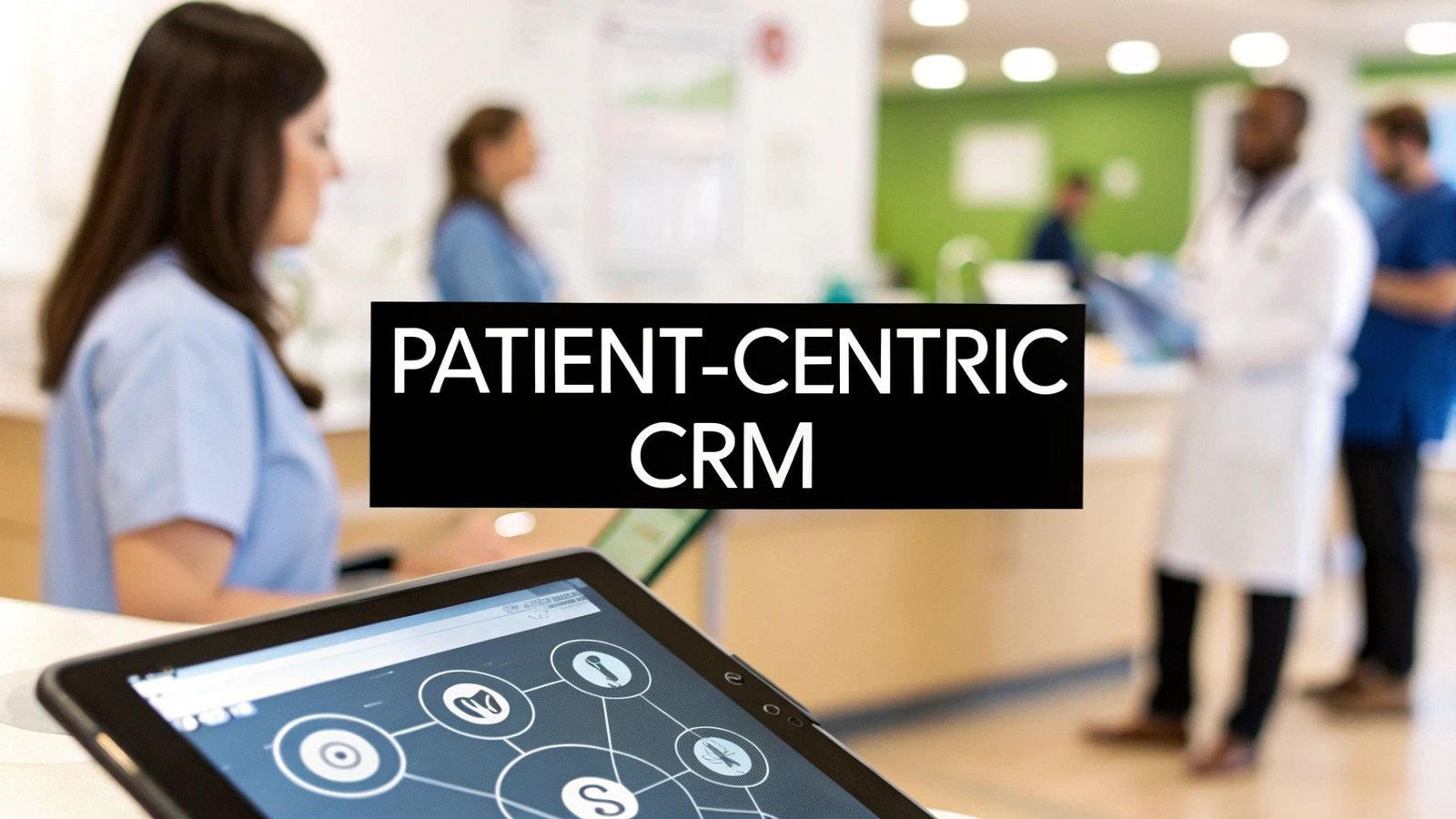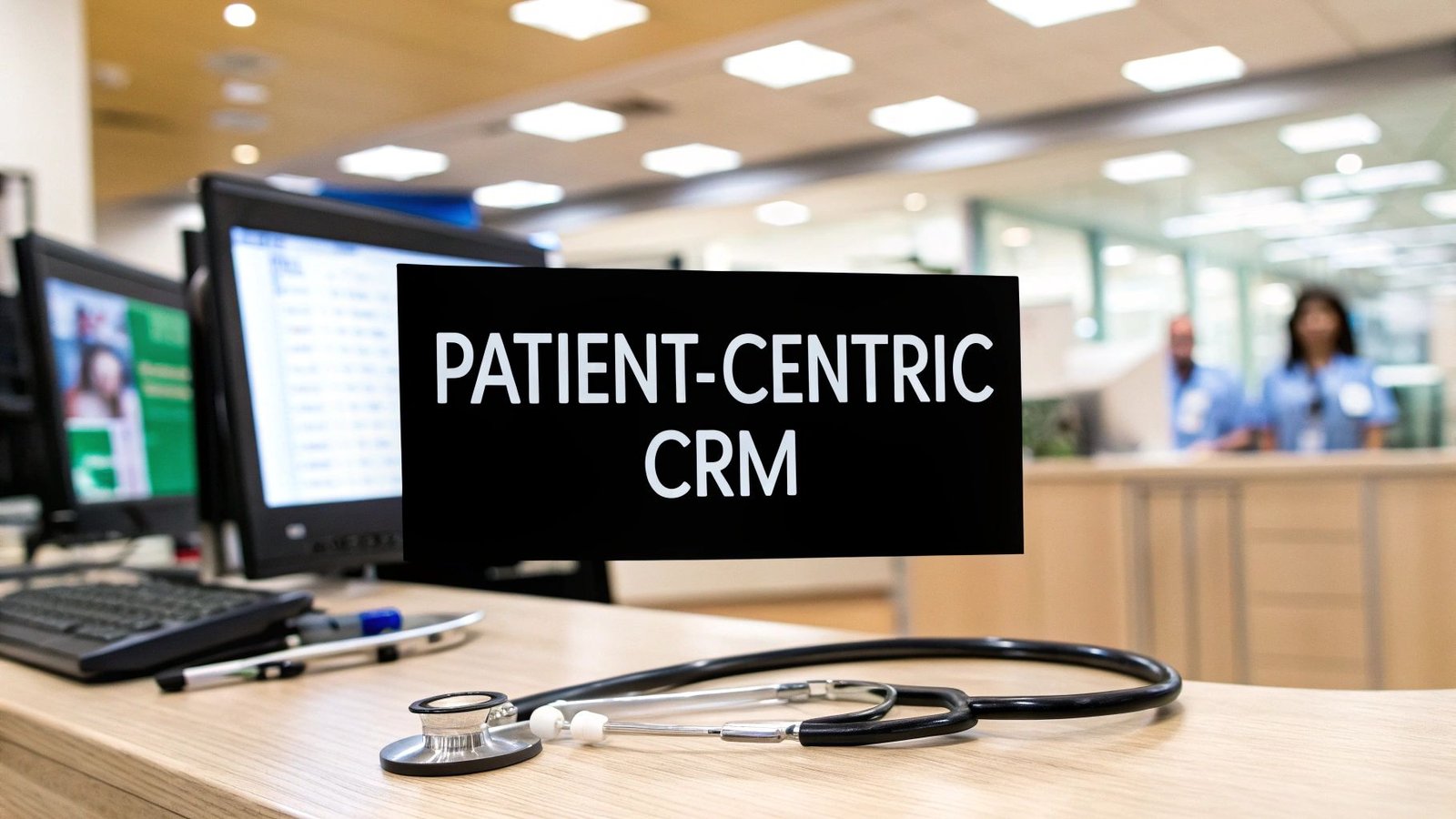Connecting the Dots in Healthcare: A Look at Leading Interoperability Solutions
Sharing patient data efficiently is crucial for modern healthcare. This listicle examines eight leading healthcare interoperability solutions, helping you choose the right tools to solve connectivity challenges. Discover how these platforms facilitate seamless data exchange, improve workflows, and enhance patient care. Explore key features and benefits of: Redox, InterSystems HealthShare, Mirth Connect (NextGen Connect), Infor Cloverleaf Integration Suite, Cerner Ignite APIs, Epic Bridges, Lyniate Rhapsody, and Microsoft Azure API for FHIR.
1. Redox
Redox is a leading healthcare interoperability solution offering a cloud-based platform that streamlines the complex process of connecting healthcare organizations with technology vendors. By standardizing healthcare data and providing a single, secure API endpoint, Redox simplifies data exchange across disparate systems. This makes it easier for healthcare providers, payers, and other stakeholders to access and share critical patient information, ultimately improving care coordination and patient outcomes. This interoperability empowers organizations to leverage data for advanced analytics, research, and reporting, fostering innovation in patient care and operational efficiency. Its ability to handle both modern and legacy systems makes it particularly valuable in today's complex healthcare IT landscape.
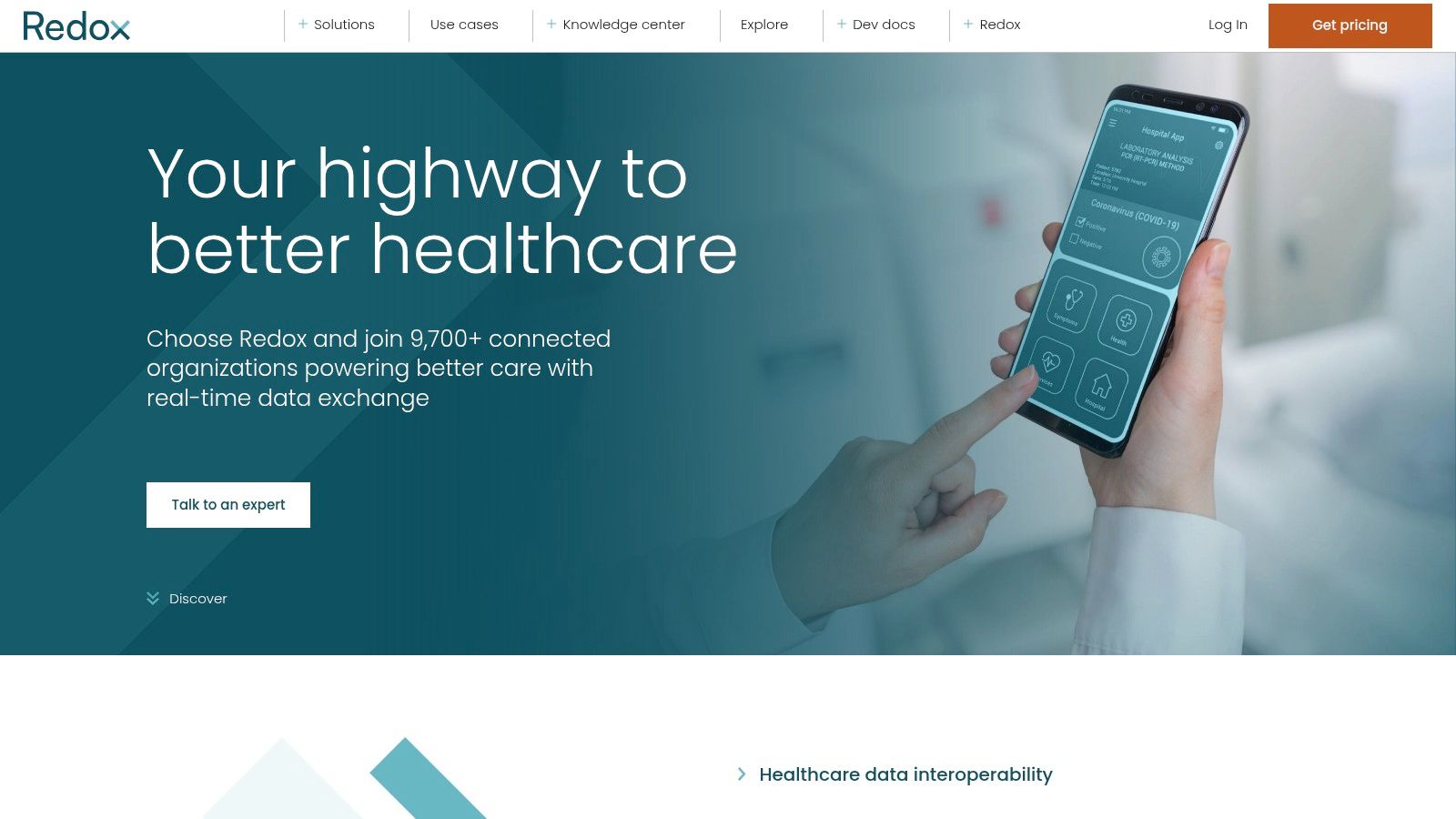
Redox’s comprehensive support for various data formats, including HL7, FHIR, X12, and C-CDA, distinguishes it as a versatile solution in the healthcare interoperability landscape. This broad compatibility simplifies integration with a wide range of existing systems, reducing the need for costly and time-consuming custom development. For medical device manufacturers, this means seamless integration of their devices with hospital systems. Healthcare technology companies can leverage Redox to quickly deploy and scale their solutions. Medical researchers and scientists gain access to standardized data for analysis, accelerating discoveries and advancements. Hospital and clinic IT departments benefit from simplified data management and improved workflow efficiency. Academic institutions focusing on medical imaging and medtech startups can use Redox to connect their innovative solutions to the broader healthcare ecosystem. Even companies specializing in DICOM communication and transfer can leverage Redox for broader interoperability solutions.
Key Features:
- Single, Unified API: Simplifies the integration process by providing a single point of connection for all data exchange needs.
- Multi-Standard Support: Handles HL7, FHIR, C-CDA, X12, and other common healthcare data standards.
- Pre-built Connections: Offers pre-built integrations with major EHR systems, accelerating implementation time.
- Real-Time Data Monitoring: Provides a dashboard for tracking data flow and identifying potential issues.
- HIPAA Compliant: Ensures secure data exchange with end-to-end encryption and robust security measures.
Pros:
- Reduced Integration Time: Significantly accelerates integration projects, often reducing timelines from months to days.
- Scalability: Suitable for organizations of all sizes, from small clinics to large hospital systems.
- Comprehensive Monitoring: Offers robust tools for troubleshooting and ensuring data integrity.
- Legacy System Compatibility: Works with both modern and legacy systems, bridging the gap between older and newer technologies.
Cons:
- Cost: Can be expensive for smaller healthcare organizations with limited budgets.
- Technical Expertise: Fully utilizing all features may require specialized technical knowledge.
- Customization: Complex customizations might require additional development work.
Implementation & Setup:
While Redox simplifies the integration process, some technical expertise is beneficial for optimal setup and configuration. Redox provides comprehensive documentation and support to assist with implementation. Engaging with their team early in the process can help define requirements and streamline the integration workflow.
Website: https://www.redoxengine.com/
Redox’s focus on simplifying healthcare interoperability through a standardized, secure, and scalable platform earns it a prominent place on this list. Its ability to drastically reduce integration time and facilitate data exchange across diverse systems makes it a valuable tool for any organization seeking to improve healthcare data management and interoperability. While cost may be a factor for smaller organizations, the long-term benefits of streamlined data exchange and improved workflow efficiency often outweigh the initial investment.
2. InterSystems HealthShare
InterSystems HealthShare is a comprehensive suite of connected health solutions designed to enhance healthcare interoperability. It achieves this by creating a unified health record, effectively connecting disparate systems and aggregating patient data from various care settings. This powerful platform provides healthcare organizations with the tools they need for seamless interoperability, robust analytics, and improved care coordination, ultimately leading to more informed clinical decisions and better patient outcomes. HealthShare earns its place on this list due to its robust feature set, extensive experience in healthcare data management, and focus on scalability and security. It’s a particularly good fit for organizations looking for a comprehensive, albeit complex, solution to their interoperability challenges.
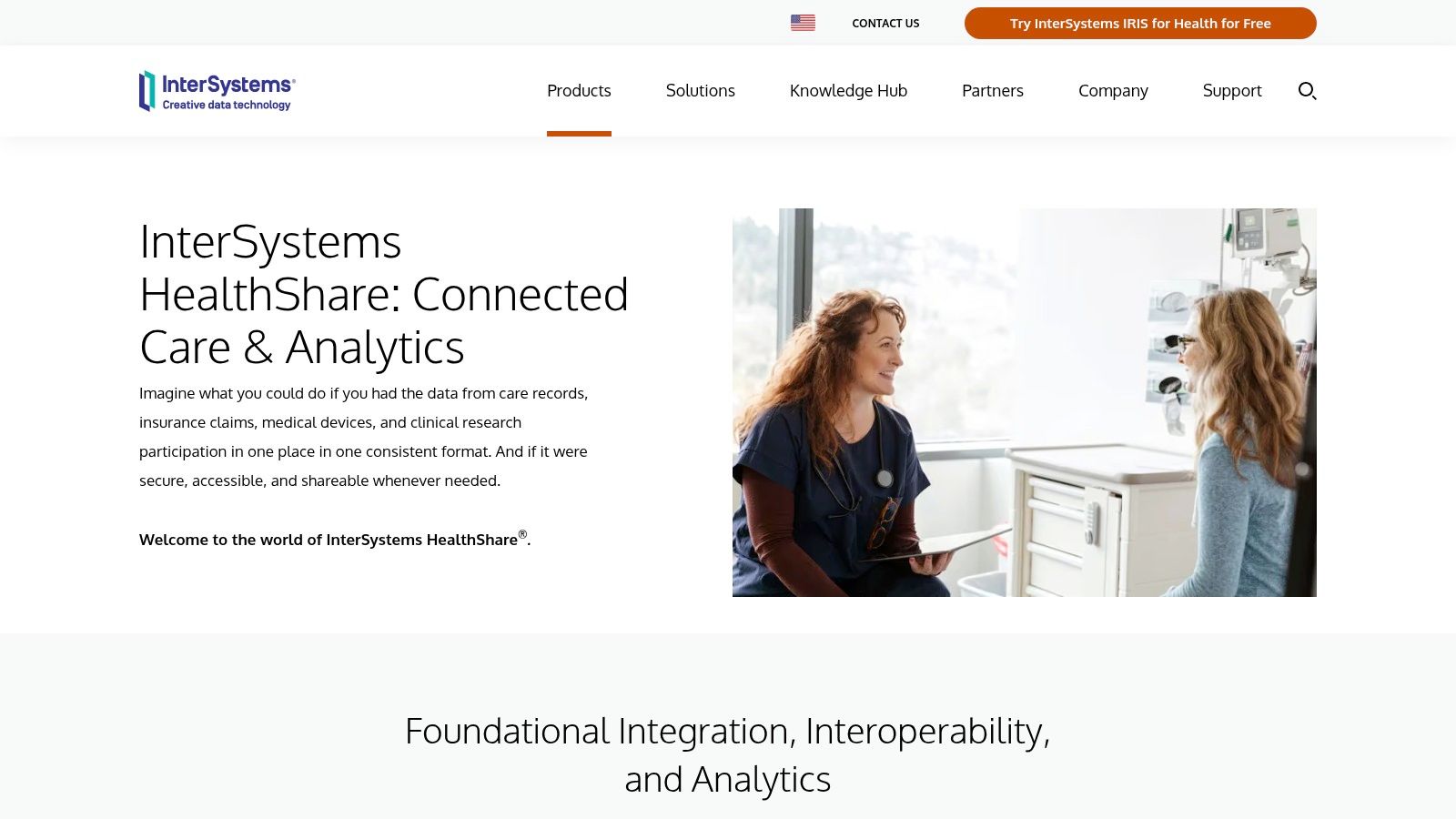
One of HealthShare's core functionalities is its Unified Care Record. This feature aggregates patient data from diverse sources, including electronic health records (EHRs), laboratory systems, radiology systems, and more, presenting a holistic view of the patient's medical history. For medical device manufacturers and healthcare technology companies, this comprehensive view can be invaluable for understanding how their products are being used and their impact on patient care. Researchers and scientists can leverage the aggregated data for large-scale studies and analysis, while hospital IT departments benefit from streamlined data management and improved workflows.
HealthShare also provides robust Health Information Exchange (HIE) capabilities, facilitating secure and efficient data sharing between different healthcare organizations. This is crucial for coordinated care, especially for patients who receive treatment from multiple providers. The platform includes a clinical viewer, offering authorized clinicians a comprehensive view of patient information, regardless of where the data originates. This can significantly improve clinical decision-making and reduce the risk of medical errors. Advanced analytics and population health management tools within HealthShare empower organizations to identify trends, manage risk, and improve overall population health outcomes. This is especially relevant for academic institutions and medtech startups focusing on data-driven healthcare solutions. Finally, HealthShare's support for key healthcare interoperability standards like FHIR, HL7, and IHE ensures seamless integration with existing systems and future-proofs your investment.
Pros:
- Extensive Experience: InterSystems has a long history in healthcare data management, providing a level of expertise and stability many competitors lack.
- Robust Scalability: HealthShare is designed to scale to the needs of large health systems and even national deployments.
- Strong Security: The platform prioritizes security and complies with international regulations, ensuring patient data privacy.
- Comprehensive Solution: HealthShare covers a wide range of interoperability needs, minimizing the need for multiple point solutions.
Cons:
- Complex Implementation: Implementing HealthShare can be complex and resource-intensive, requiring careful planning and execution.
- Higher Cost: Compared to some competitors, HealthShare may be a more expensive option.
- Steeper Learning Curve: Users may require significant training to fully utilize the platform's capabilities.
Pricing and Technical Requirements:
Pricing for InterSystems HealthShare is typically tailored to the specific needs and scale of each organization. Contacting InterSystems directly is recommended for detailed pricing information. Technical requirements vary depending on the specific components implemented and the existing infrastructure. InterSystems provides detailed documentation and support to guide the implementation process.
Implementation Tips:
- Thorough Planning: Engage all relevant stakeholders early in the planning process to ensure a smooth implementation.
- Dedicated Resources: Allocate sufficient resources for the implementation, including IT staff, training, and ongoing support.
- Phased Approach: Consider a phased implementation approach to minimize disruption and allow for adjustments along the way.
Website: https://www.intersystems.com/products/healthshare/
3. Mirth Connect (NextGen Connect)
Mirth Connect, now rebranded as NextGen Connect, stands as a prominent open-source healthcare integration engine, empowering the bi-directional exchange of medical information between disparate systems and applications. Its strength lies in facilitating interoperability by transforming and routing data across a multitude of formats, encompassing HL7, DICOM, XML, and FHIR. This versatility positions NextGen Connect as a cost-effective healthcare interoperability solution for organizations of all sizes, from small clinics to large hospital networks. This adaptability and cost-effectiveness are key reasons for its inclusion in this list.
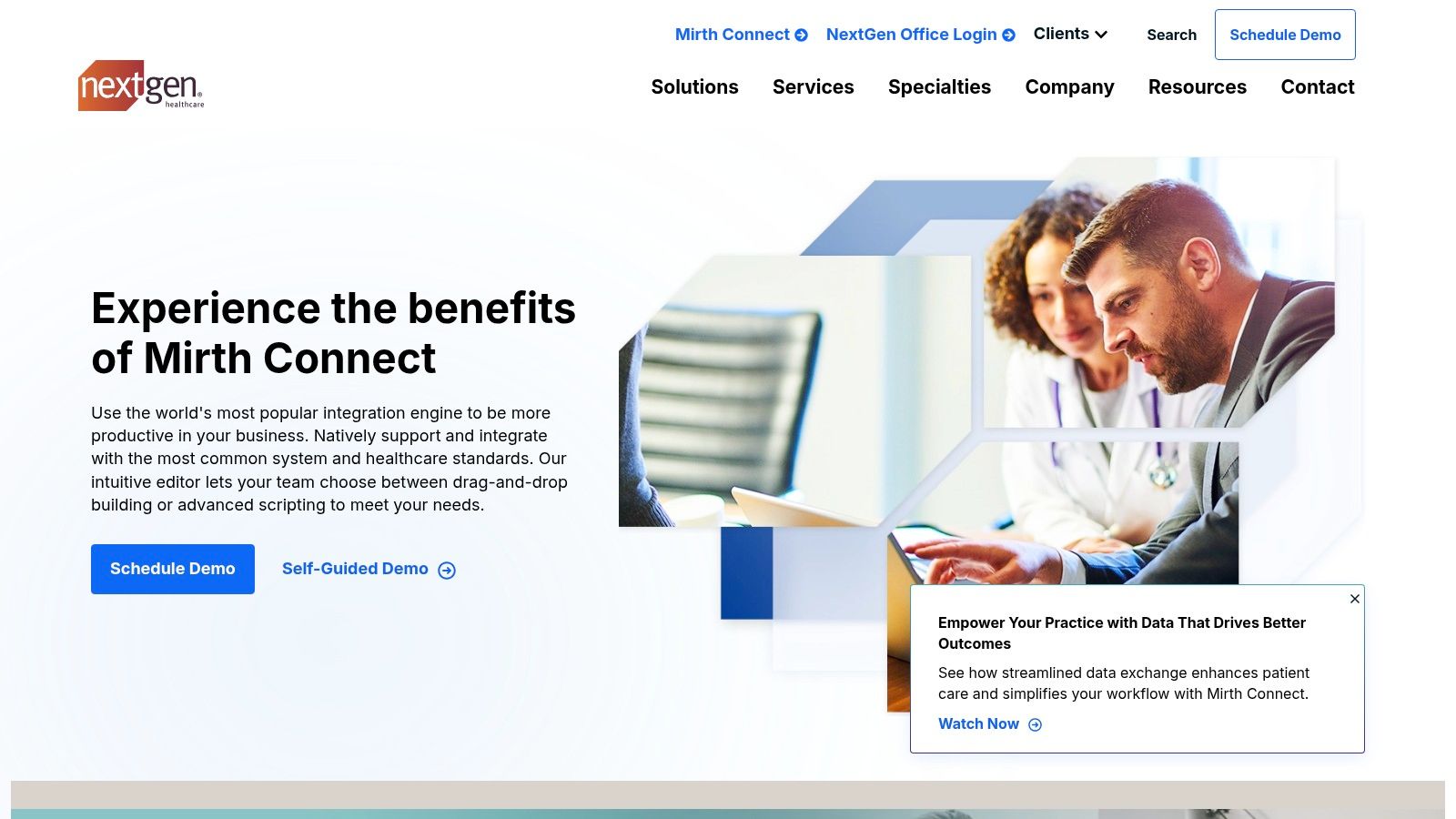
NextGen Connect's channel-based architecture simplifies message processing, providing a visual workflow for managing data transformations and routing. This feature makes it particularly relevant for complex integration scenarios, such as connecting medical devices to electronic health record (EHR) systems or enabling image sharing via DICOM between radiology departments and other healthcare providers. For medical device manufacturers, this means seamless integration of their devices with existing hospital infrastructure. Healthcare technology companies can leverage NextGen Connect to build interoperable solutions that connect various healthcare systems. Medical researchers and scientists benefit from its ability to aggregate data from diverse sources for analysis, while hospital and clinic IT departments can use it to streamline workflows and improve data exchange. Academic institutions focusing on medical imaging can employ it for educational and research purposes, particularly given its robust DICOM support. Even medtech startups and DICOM communication and transfer companies can leverage its open-source nature and flexibility for cost-effective solutions.
Its web-based administration interface simplifies management and monitoring, providing a centralized platform for overseeing the flow of healthcare data. The platform’s extensive transformation capabilities enable organizations to map data between different formats, ensuring semantic interoperability and enabling effective communication between systems that may use different data standards. This is particularly valuable for organizations looking to leverage FHIR, the emerging standard for healthcare interoperability.
Features:
- Open-source integration engine with commercial support options
- Channel-based architecture for message processing
- Support for multiple healthcare data standards (HL7, DICOM, XML, FHIR)
- Web-based administration interface
- Extensive transformation capabilities
Pros:
- Cost-effective solution with open-source availability
- Flexible deployment options (cloud, on-premise)
- Active community support and resources
- Highly customizable to specific organizational needs
Cons:
- May require more technical expertise to implement and maintain
- Interface can be less intuitive than some commercial alternatives
- Advanced features may require commercial licensing
- Support response time may vary based on license type
Pricing: While the core NextGen Connect software is open-source and free to use, commercial support and advanced features are available through subscription licensing. Contact NextGen Healthcare for specific pricing details.
Technical Requirements: NextGen Connect can be deployed on various operating systems and requires a Java runtime environment. Specific requirements vary based on deployment configuration and data volumes. Refer to the official documentation for detailed information.
Implementation Tips: Start with a well-defined scope and map out your integration needs. Leverage the active community forums and documentation for guidance. Consider engaging NextGen Healthcare’s professional services for complex implementations or if you require dedicated support.
Comparison: While other commercial healthcare interoperability solutions exist, NextGen Connect's open-source nature offers greater flexibility and cost control, particularly for organizations with in-house technical expertise. It provides a powerful and versatile platform that can be tailored to meet the unique needs of diverse healthcare organizations.
Website: https://www.nextgen.com/products-and-services/integration-engine
4. Infor Cloverleaf Integration Suite
Infor Cloverleaf Integration Suite is a robust and comprehensive healthcare interoperability solution designed to tackle the complex challenge of connecting disparate systems within a healthcare ecosystem. This makes it a powerful tool for medical device manufacturers, healthcare technology companies, researchers, hospital IT departments, academic institutions, and medtech startups grappling with data exchange issues. Its decades of experience in the field position it as a mature and reliable choice for organizations seeking a comprehensive, albeit potentially complex, solution.
Cloverleaf excels at managing the flow of clinical, financial, and operational data across an entire healthcare enterprise. It acts as a central hub, enabling seamless communication between various applications, databases, medical devices, and even external partners. This interoperability is crucial for enhancing patient care, streamlining workflows, and fostering data-driven decision-making.
Key Features and Benefits:
- End-to-End Data Integration: Cloverleaf facilitates the seamless exchange of data across your entire healthcare ecosystem, breaking down data silos and enabling a holistic view of patient information. This is particularly beneficial for medical researchers and scientists who require access to diverse datasets.
- Standards-Based Interoperability: The platform supports all major healthcare interoperability standards and protocols, including HL7, FHIR, DICOM, and X12. This broad compatibility simplifies integration with a wide range of systems and ensures compliance with industry regulations, a vital concern for medical device manufacturers and healthcare technology companies. For those working with medical imaging, the robust DICOM support is essential.
- Centralized Monitoring and Management: A centralized console simplifies oversight and control, allowing administrators to monitor data flows, manage interfaces, and troubleshoot issues proactively. This is critical for hospital and clinic IT departments responsible for maintaining system uptime and data integrity.
- High-Performance Message Processing: Cloverleaf's architecture is designed for high-volume message processing, ensuring efficient data transfer even during peak loads. This scalability is vital for enterprise-level deployments in large hospital systems.
- Secure Data Transmission: Robust security features, including encryption and access controls, protect sensitive patient data during transmission and storage, meeting stringent healthcare data privacy requirements. This is paramount for all organizations handling patient health information.
Pros:
- Mature and Proven: Decades of industry experience translate to a reliable and stable platform.
- Highly Scalable: Cloverleaf is designed to handle the demands of large healthcare enterprises.
- Comprehensive Monitoring and Alerting: Proactive monitoring tools help prevent potential issues and ensure system uptime.
- Legacy System Support: Cloverleaf can integrate with older systems, simplifying transitions and maximizing existing IT investments.
Cons:
- Cost: Cloverleaf's comprehensive features and enterprise-grade capabilities come with a higher price tag compared to open-source alternatives. Pricing is typically based on the number of interfaces and message volume, and potential users should contact Infor directly for a customized quote.
- Complexity: Implementing and managing Cloverleaf can be complex, requiring specialized expertise. Organizations may need to invest in training or engage external consultants.
- Feature Richness: The extensive feature set can be overwhelming for smaller organizations with simpler integration needs.
Implementation and Setup Tips:
- Thorough Planning: Begin with a detailed assessment of your integration needs and clearly define your objectives.
- Expert Consultation: Consider engaging Infor professional services or an experienced integration partner for implementation and configuration.
- Phased Approach: For complex projects, a phased rollout can minimize disruption and facilitate testing and validation.
Comparison with Similar Tools:
While other integration engines exist (e.g., Mirth Connect, InterSystems Ensemble), Cloverleaf distinguishes itself through its deep healthcare specialization, mature feature set, and focus on enterprise-level deployments. However, organizations with limited budgets or simpler integration needs may find open-source alternatives more suitable.
Website: https://www.infor.com/products/cloverleaf-integration
Infor Cloverleaf Integration Suite deserves its place on this list of healthcare interoperability solutions due to its comprehensive features, proven track record, and focus on addressing the complex integration challenges faced by healthcare organizations of all sizes. While the cost and complexity might be a barrier for some, its robust capabilities and focus on security make it a strong contender for organizations seeking a powerful and reliable healthcare interoperability platform.
5. Cerner Ignite APIs
Cerner Ignite APIs offer a powerful suite of tools for enhancing healthcare interoperability solutions, specifically within the Cerner ecosystem. These application programming interfaces (APIs) empower developers to create applications that seamlessly integrate with Cerner's Electronic Health Record (EHR) platform. This interoperability is achieved through secure data exchange with Cerner systems, leveraging the industry-standard FHIR (Fast Healthcare Interoperability Resources) protocol. This opens doors for innovation and extends the functionality of the existing Cerner EHR environment. For organizations already invested in Cerner, Ignite APIs provide a robust pathway to improve workflows, introduce new features, and contribute to a more connected healthcare experience.
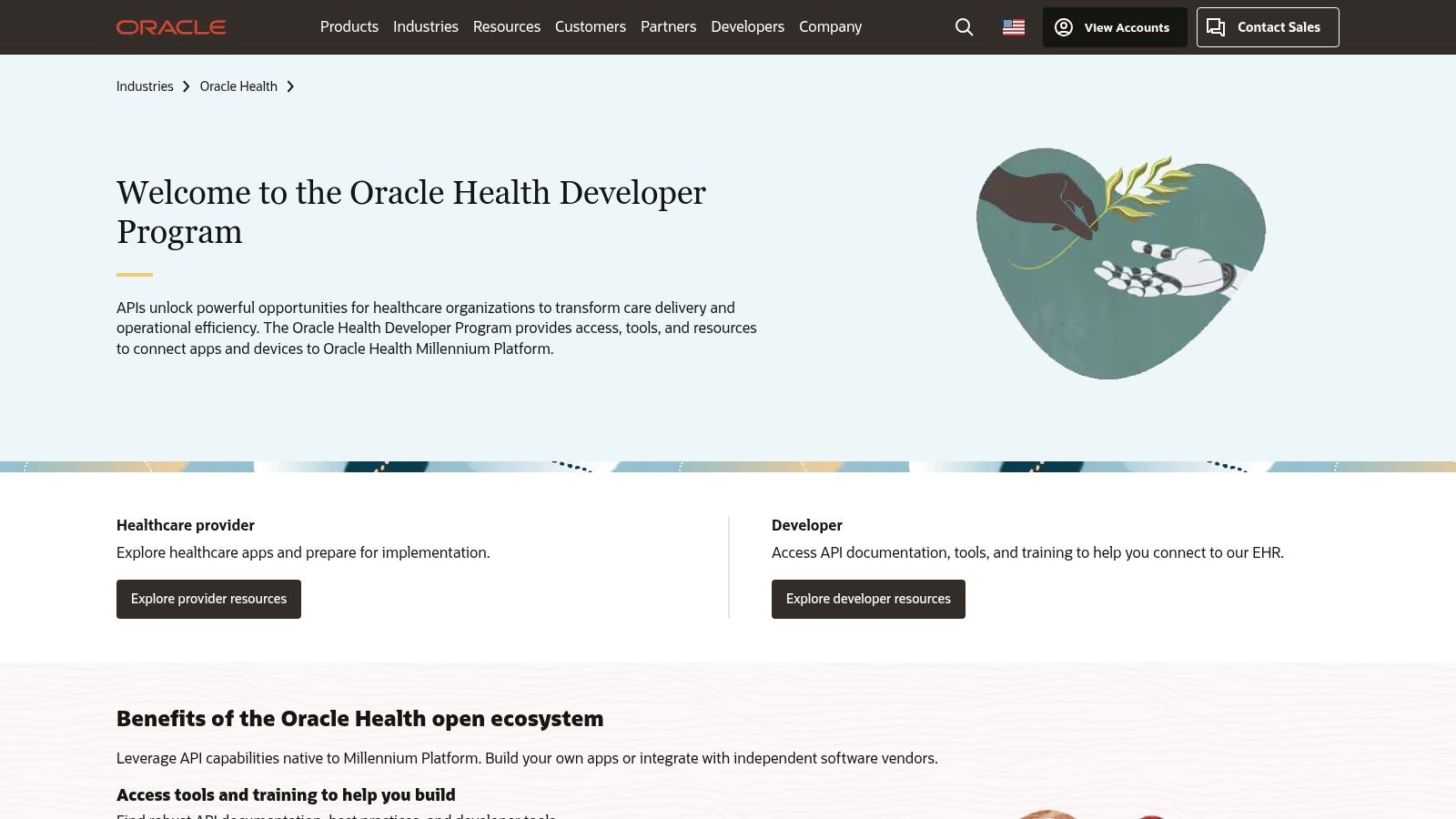
Cerner Ignite APIs provide FHIR-based RESTful APIs, making it easier for developers to access and exchange healthcare data. This standards-based approach is crucial for interoperability, ensuring that different systems can communicate effectively. The APIs support both read and write operations, allowing for comprehensive data integration. Developers benefit from detailed documentation, resources, and real-world testing environments, streamlining the development process. Robust security mechanisms, including authentication and authorization protocols, are in place to protect sensitive patient health information (PHI).
Practical Applications and Use Cases:
- Medical Device Integration: Connect medical devices directly to the Cerner EHR, automating data capture and reducing manual entry errors. This is particularly relevant for medical device manufacturers and medtech startups seeking seamless integration with hospital systems.
- Healthcare App Development: Create mobile or web applications that interact with patient data stored in Cerner, offering personalized healthcare services or remote monitoring capabilities. This is valuable for healthcare technology companies and academic institutions focusing on medical innovation.
- Research and Analytics: Extract de-identified patient data for research purposes, enabling population health studies and advancements in medical science. This benefits medical researchers and scientists looking to leverage large datasets for analysis.
- Workflow Optimization: Develop applications that streamline administrative tasks, automate clinical workflows, and enhance communication between care providers within a Cerner environment. This is especially useful for hospital and clinic IT departments.
- DICOM Integration: Though not explicitly stated, the potential for integrating DICOM data through FHIR wrappers or custom API development could be explored, benefiting institutions focused on medical imaging and DICOM communication and transfer.
Pros:
- Tight integration with Cerner EHR systems minimizes compatibility issues and simplifies development.
- Adherence to FHIR standards promotes broader interoperability within the healthcare ecosystem.
- Robust security protocols safeguard patient data and ensure compliance with regulations like HIPAA.
- A growing ecosystem of supported applications enhances the overall value and functionality of Cerner systems.
Cons:
- The primary benefit is realized by organizations already using Cerner EHR. Its utility is limited in heterogeneous environments with multiple EHR vendors.
- Integrating with non-Cerner systems requires additional effort and may involve custom solutions.
- Participating in the Cerner Ignite developer program might have associated requirements and costs. Specific details on pricing and technical requirements are not readily available and may require contacting Cerner directly.
Implementation and Setup:
Getting started with Cerner Ignite APIs typically involves enrolling in the Cerner Developer Program (check the website for current details). This provides access to the necessary documentation, tools, and support resources. Developers should familiarize themselves with FHIR standards and RESTful API principles. Utilizing the provided testing environments allows for safe and effective development before deploying applications in live clinical settings.
Comparison with Similar Tools:
While other EHR vendors offer APIs for integration, Cerner Ignite APIs distinguish themselves through their tight integration with the Cerner ecosystem and the growing community of developers building applications specifically for Cerner environments. Epic's App Orchard and Allscripts' open platform are comparable offerings, but their utility is primarily confined to their respective EHR ecosystems.
Website: https://code.cerner.com/
Cerner Ignite APIs earn their place in this list by providing a robust, secure, and standards-based approach to healthcare interoperability within the Cerner environment. This empowers healthcare organizations to leverage their existing EHR investment to drive innovation, improve patient care, and enhance operational efficiency.
6. Epic Bridges
Epic Bridges is a powerful interface engine specifically designed for Epic's EHR system, making it a key player in healthcare interoperability solutions, particularly within Epic-centric environments. It facilitates data exchange between Epic and other healthcare applications, supporting various industry standards and protocols for seamless integration. Bridges handles both inbound and outbound interfaces, transforming data between disparate formats to ensure interoperability across the healthcare ecosystem. This capability is crucial for organizations using Epic's EHR and needing to connect with other systems, such as labs, pharmacies, and other healthcare providers.
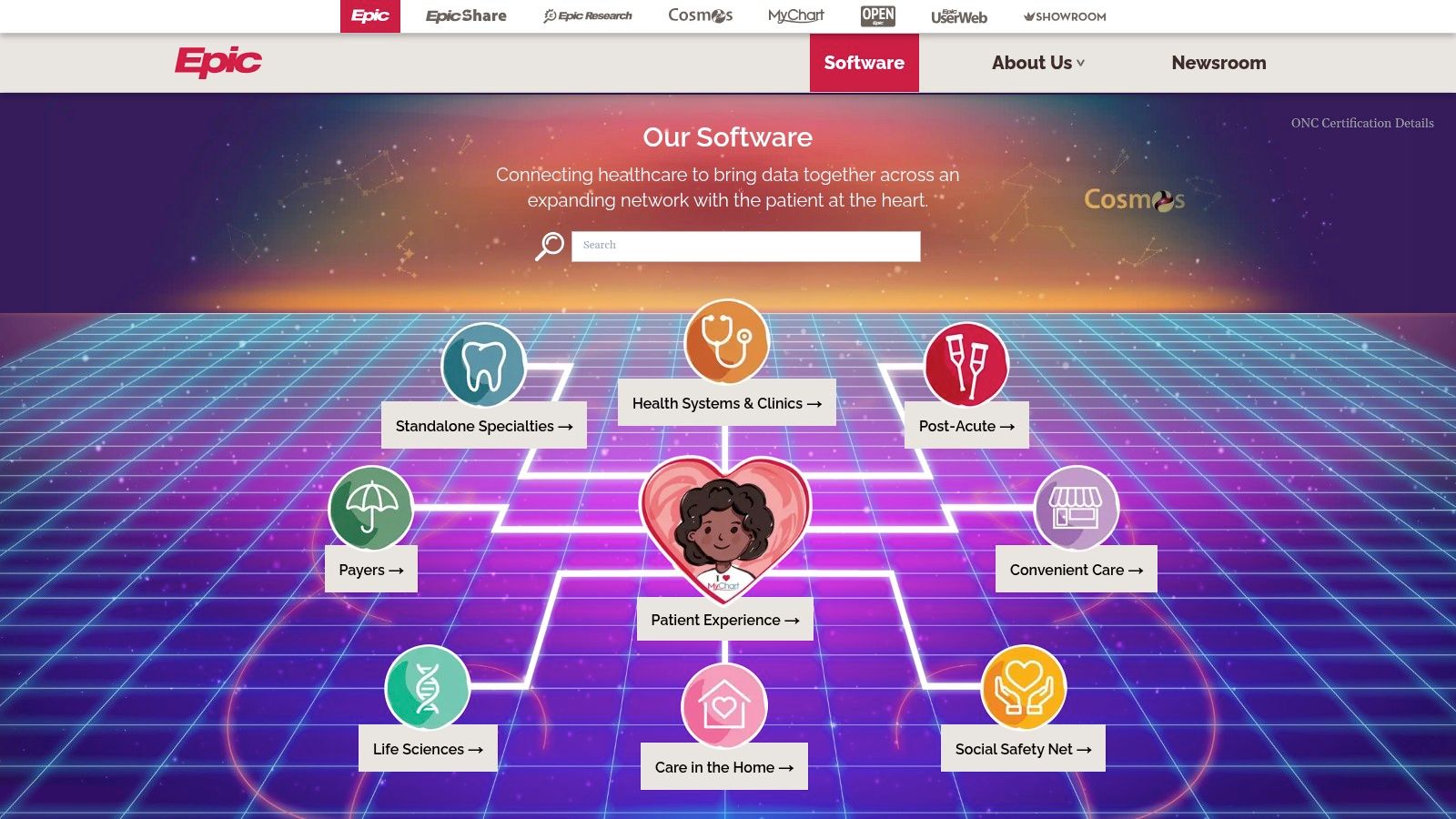
For instance, a hospital using Epic can leverage Bridges to seamlessly transmit patient data to a specialist using a different EHR system, ensuring coordinated care. Similarly, a lab can use Bridges to efficiently receive orders from and send results back to an Epic-based clinic, streamlining workflows and reducing manual data entry. Bridges supports HL7, FHIR, and other healthcare standards, providing flexibility and facilitating wider interoperability. Its interface mapping and transformation capabilities allow for customization based on the specific needs of the healthcare organization. Built-in monitoring tools provide oversight of interface performance, enabling proactive identification and resolution of potential issues. Secure data exchange protocols safeguard protected health information (PHI) during transmission.
A significant advantage of Epic Bridges is its native integration with the Epic EHR environment. This tight coupling results in optimized performance and leverages Epic's established infrastructure. Furthermore, Bridges benefits from consistent updates aligned with Epic's release cycles, ensuring compatibility and access to the latest features. Dedicated Epic support resources are readily available to assist with implementation, maintenance, and troubleshooting.
However, Epic Bridges' specialization also presents some limitations. Its utility is primarily confined to Epic-centric environments, making it less suitable for organizations utilizing different EHR systems. Implementing and managing Bridges requires specialized Epic expertise, which can be a resource constraint for some organizations. Compared to vendor-neutral interface engines, Bridges offers less flexibility for non-standard integration scenarios.
While pricing information for Epic Bridges is not publicly available, it's typically based on factors like the number of interfaces and data volume. Technical requirements are also specific to each implementation and depend on the integrated systems. Organizations considering Epic Bridges should engage with Epic directly to obtain detailed pricing and technical specifications tailored to their needs.
Compared to vendor-neutral interface engines like Mirth Connect or Cloverleaf, Epic Bridges shines within Epic ecosystems, offering streamlined integration and dedicated support. However, for organizations seeking interoperability solutions across a more diverse range of systems, a vendor-neutral option might offer greater flexibility.
Implementation tips for Epic Bridges include thorough planning and assessment of integration requirements, involving relevant stakeholders from both the Epic environment and the connecting systems. Engaging experienced Epic-certified interface specialists is highly recommended for successful implementation and ongoing management.
For more detailed information about Epic Bridges and its capabilities, visit the Epic website: https://www.epic.com/software
7. Lyniate Rhapsody: A Robust Healthcare Interoperability Solution
Lyniate Rhapsody (formerly Rhapsody Integration Engine) is a powerful healthcare interoperability solution designed to tackle the complex challenge of connecting disparate systems within and across healthcare organizations. Its robust architecture and comprehensive feature set make it a compelling option for organizations looking to streamline data exchange and improve operational efficiency. This makes it particularly relevant for medical device manufacturers, healthcare technology companies, researchers, hospital IT departments, academic institutions, and medtech startups dealing with complex data integration needs.
Rhapsody excels at enabling seamless data exchange by supporting various healthcare standards and protocols, including HL7, FHIR, DICOM, and X12. This broad compatibility simplifies the integration of various systems, such as EHRs, EMRs, laboratory information systems (LIS), radiology information systems (RIS), and medical devices. For companies specializing in DICOM communication and transfer, Rhapsody's robust support for the standard is a significant advantage.
Key Features and Benefits:
- Intuitive Visual Interface: Rhapsody simplifies complex integration tasks with its user-friendly visual interface for mapping and transforming data. This low-code approach allows users with less technical expertise to manage integrations effectively, reducing the need for specialized development resources. This is a considerable benefit for organizations with limited IT staff.
- Comprehensive Standard Support: Supporting all major healthcare data standards like HL7 v2, HL7 v3, FHIR, DICOM, and X12 ensures interoperability across a wide range of systems and devices. This is crucial for medical researchers and academic institutions working with diverse data sources.
- Pre-built Connectors and Templates: Rhapsody's extensive library of pre-built connectors and templates accelerates implementation and reduces development time. This is particularly helpful for medtech startups looking to quickly integrate their solutions with existing healthcare infrastructure.
- High-Performance Message Processing: With its high-performance engine, Rhapsody ensures low-latency message processing, even with high message volumes. This is essential for hospitals and clinics dealing with large amounts of patient data.
- Comprehensive Monitoring and Alerting: Robust monitoring and alerting capabilities enable proactive identification and resolution of potential issues, ensuring continuous and reliable data flow.
Pros:
- User-friendly design reduces the need for specialized technical expertise.
- Flexible deployment options (cloud, on-premise, hybrid) cater to diverse organizational needs.
- Excellent performance handling high message volumes ensures efficient data exchange.
- Strong customer support and implementation assistance facilitate smooth onboarding.
Cons:
- Licensing costs can be higher compared to open-source alternatives, which may be a concern for smaller organizations or startups.
- Some advanced features may require additional modules, potentially increasing overall costs.
- The platform's comprehensive capabilities might be oversized for smaller healthcare organizations with limited integration needs.
Implementation and Setup Tips:
While Rhapsody offers a user-friendly interface, proper planning and training are essential for successful implementation. Engage with Lyniate's professional services or experienced integration partners for optimal configuration and customization. Start with a pilot project to test integrations and refine workflows before full-scale deployment.
Pricing and Technical Requirements:
Specific pricing information is not publicly available and typically requires contacting Lyniate directly. Technical requirements vary depending on the chosen deployment option (cloud, on-premise, or hybrid) and the specific integration needs. Contact Lyniate for detailed technical specifications.
Comparison with Similar Tools:
Compared to other healthcare interoperability solutions like InterSystems Ensemble or Mirth Connect, Rhapsody offers a strong balance of user-friendliness, performance, and comprehensive features. While Mirth Connect might be a more budget-friendly option for smaller organizations due to its open-source nature, Rhapsody’s robust features and support make it a more suitable choice for organizations with complex integration requirements.
Website: https://lyniate.com/rhapsody/
Lyniate Rhapsody earns its place on this list due to its comprehensive capabilities, robust performance, and focus on simplifying healthcare interoperability challenges. Its user-friendly design, combined with its extensive support for healthcare standards, makes it a valuable tool for organizations of all sizes seeking to improve data exchange and streamline their operations. While cost might be a factor, the potential ROI through improved efficiency and interoperability makes it a compelling solution for organizations serious about addressing their healthcare integration needs.
8. Microsoft Azure API for FHIR
Microsoft Azure API for FHIR is a powerful healthcare interoperability solution offering a managed, standards-based, compliant API for clinical health data. This robust platform facilitates the rapid exchange of data through FHIR APIs, simplifying complex integration challenges for healthcare organizations. By providing a serverless deployment of the FHIR standard with enterprise-grade security and compliance, Azure API for FHIR allows seamless connectivity and interaction with any system utilizing the FHIR standard. This makes it particularly attractive for organizations looking to modernize their health data infrastructure and leverage the benefits of a cloud-based solution.
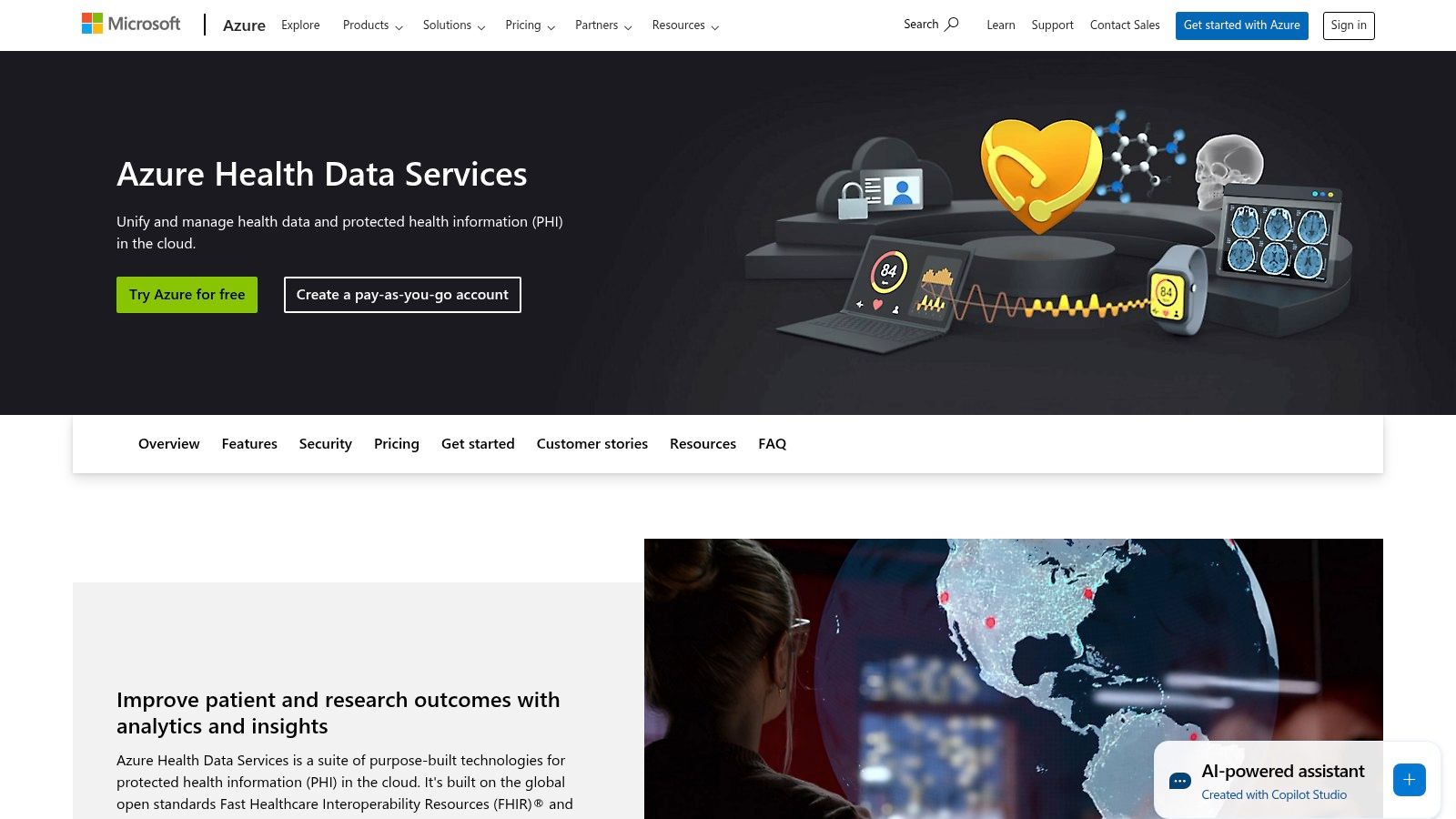
Practical Applications and Use Cases:
Azure API for FHIR unlocks numerous possibilities across the healthcare ecosystem. For medical device manufacturers, it simplifies the process of connecting devices to electronic health records (EHRs), enabling real-time data streaming and remote patient monitoring. Healthcare technology companies can leverage it to build innovative applications that access and analyze patient data securely and efficiently, driving advancements in personalized medicine and population health management. Medical researchers and scientists gain a valuable tool for accessing and analyzing large datasets of FHIR-structured data, accelerating research and discovery. Hospital and clinic IT departments can utilize Azure API for FHIR to streamline data exchange between different systems within their organization, improving care coordination and operational efficiency. Finally, academic institutions can utilize this tool for education and research related to health informatics and interoperability. Medtech startups and companies working with DICOM communication and transfer can also leverage FHIR APIs as a bridge to integrate imaging data into a wider healthcare data ecosystem, although additional tooling and expertise may be required to handle the specific complexities of DICOM.
Key Features and Benefits:
- Managed PaaS Offering: High availability and scalability are built-in, reducing the burden on IT teams.
- FHIR R4 Standard Support: Ensures interoperability with a wide range of FHIR-compliant systems.
- Azure Active Directory Integration: Provides robust authentication and authorization capabilities.
- SMART on FHIR Support: Enables secure authorization of third-party applications.
- Comprehensive Auditing and Monitoring: Facilitates compliance with regulatory requirements.
Pros:
- Seamless Azure Integration: Leverages the broader Azure ecosystem for data storage, analytics, and machine learning.
- Pay-as-you-go Pricing: Offers flexibility and potentially lower initial investment compared to on-premise solutions.
- Robust Security: Benefits from Microsoft's security infrastructure and role-based access control.
- Global Infrastructure: Ensures performance and compliance across different regions.
Cons:
- Azure Expertise Required: Optimal implementation may necessitate specialized Azure skills.
- FHIR Focus: While a strength, the primary focus on FHIR might require supplementary solutions for legacy systems.
- Ongoing Cloud Costs: Depending on usage, cloud costs can potentially exceed on-premise solutions in certain scenarios.
Pricing and Technical Requirements:
Azure API for FHIR utilizes a pay-as-you-go pricing model based on requests, data storage, and data egress. Detailed pricing information is available on the Azure website. Technical requirements include familiarity with FHIR, RESTful APIs, and Azure cloud services.
Implementation Tips:
- Carefully plan your FHIR data model and API usage patterns to optimize costs.
- Leverage Azure Active Directory for authentication and authorization.
- Explore Azure's other healthcare services for a comprehensive interoperability solution.
- Consider using FHIR transformation tools to bridge the gap between legacy systems and the FHIR standard.
Why it Deserves its Place on the List:
Microsoft Azure API for FHIR stands out as a robust and scalable healthcare interoperability solution, particularly for organizations already invested in the Azure ecosystem. Its managed service offering simplifies FHIR implementation, while its enterprise-grade security and compliance features instill confidence. By offering a clear path to FHIR-based interoperability, Azure API for FHIR empowers healthcare organizations to unlock the full potential of their data.
Website: https://azure.microsoft.com/en-us/services/healthcare-apis/
Healthcare Interoperability Solutions Comparison
| Solution | Core Features & Standards ✨ | User Experience & Quality ★★★★ | Value & Pricing 💰 | Target Audience 👥 | Unique Selling Points 🏆 |
|---|---|---|---|---|---|
| Redox | Unified API, HL7/FHIR/X12 support, real-time monitoring | Scalable, robust monitoring, technical expertise needed | Higher cost, enterprise-focused | Medium to large healthcare orgs | Fast integration, supports legacy & modern systems |
| InterSystems HealthShare | Unified care record, HIE, analytics, FHIR/HL7/IHE | Comprehensive, steep learning curve, scalable | Premium price, resource intensive | Large health systems, national scale | Extensive data management, strong security & compliance |
| Mirth Connect (NextGen) | Open-source, multi-standard support, web admin | Flexible, customizable, community-supported | Low cost/open-source option | All sizes, tech-savvy orgs | Open-source flexibility, multiple deployment options |
| Infor Cloverleaf | End-to-end integration, supports major standards | Mature, scalable, complex implementation | Higher cost, enterprise-oriented | Large enterprises | Proven solution, high-performance processing |
| Cerner Ignite APIs | FHIR RESTful APIs, secure auth, dev-friendly docs | Tight Cerner integration, developer tools | Variable costs, Cerner ecosystem | Cerner-based systems | Direct Cerner EHR integration, standards-based |
| Epic Bridges | Epic EHR integration, HL7/FHIR support, monitoring | Optimized for Epic, reliable, expert required | High cost, Epic-specific | Epic users | Native Epic integration, aligned with Epic updates |
| Lyniate Rhapsody | Visual interface, major standards, pre-built templates | User-friendly, high performance, flexible deployment | Premium licensing | Medium to large orgs | Intuitive, strong support, handles high message volumes |
| Microsoft Azure API for FHIR | Managed FHIR API, Azure AD auth, SMART on FHIR | Seamless Azure integration, pay-as-you-go | Flexible cloud pricing | Cloud-focused healthcare orgs | Enterprise-grade security, global infrastructure |
The Future of Interconnected Healthcare
The healthcare landscape is rapidly evolving, with interoperability at its forefront. This exploration of leading healthcare interoperability solutions, including Redox, InterSystems HealthShare, Mirth Connect (NextGen Connect), Infor Cloverleaf Integration Suite, Cerner Ignite APIs, Epic Bridges, Lyniate Rhapsody, and Microsoft Azure API for FHIR, provides a crucial starting point for organizations seeking to enhance their data exchange capabilities. The key takeaway is that there is no one-size-fits-all solution. The ideal choice depends on your specific needs, existing infrastructure, budget, and long-term goals.
When selecting a healthcare interoperability solution, consider factors like scalability, security, compliance with regulations like HIPAA, and the vendor’s reputation and support. A thorough evaluation of these aspects will ensure a seamless integration process and maximize the benefits of improved data flow. Furthermore, understanding the nuances of patient expectations and service delivery is becoming increasingly important. For a deeper dive into the trends shaping the future of customer satisfaction and retention in healthcare, exploring relevant data can be highly valuable. Check out these customer success statistics from Statisfy.
By embracing the power of healthcare interoperability solutions, organizations can break down data silos, facilitate seamless data exchange, and ultimately improve patient care, accelerate research, and drive innovation across the healthcare ecosystem. The future of healthcare hinges on connected systems, and the tools discussed here are paving the way for a more integrated and patient-centric approach. Streamline your DICOM file processing and enhance your interoperability workflows with PYCAD, a powerful platform designed specifically for medical image management. Learn more about how PYCAD can revolutionize your healthcare data exchange at PYCAD.
